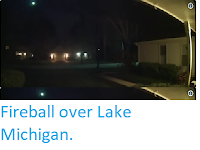The
Perseid Meteor shower lasts from late July to early September each
year, and are expected to be at a peak on Tuesday 13 August
2019. Since the Moon is currently more than half full and still waxing (becoming more full), viewing will not be perfect for the Perseids this year. The
Perseids get their name from the constellation of Perseus, in which the
meteors have their radiant (the point from which they appear to
originate).
The radiant of the Perseid Meteors. Sky & Telescope Magazine.
The shower is caused by the Earth passing through the trail of the Comet
109P/Swift-Tuttle, and encountering dust from the tail of this comet.
The dust particles strike the atmosphere at speeds of over 200 000 km
per hour, burning up in the upper atmosphere and producing a light show
in the process.
109P/Swift-Tuttle is currently 38.6 AU from the Sun (i.e. 38.6 times as far from the Sun as Earth and some way outside the orbit of Neptune) and 39.4 AU from the Earth. The comet is next expected to visit the Inner Solar System in 2126, reaching about 22 950 00 km (0.15 AU) from Earth in August of that year.
See also...
Follow Sciency Thoughts on Facebook.








